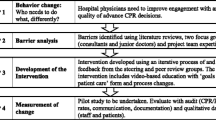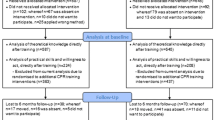Abstract
Objective: To assess the relationship between cardiopulmonary resuscitation (CPR) information and desire for CPR in an elderly population and to determine the influence of outcome data on desire for CPR in older persons.
Design: An interventional study utilizing an educational program.
Setting: Elderly independent retirement community.
Participants: One hundred two persons, all more than 62 years old, who were neither demented nor depressed.
Intervention: Participants received an educational intervention consisting of descriptive CPR information and quantitative information about CPR outcomes. CPR information, survival estimates, and preferences were recorded prior to and after the intervention.
Measurements and main results: Subjects exhibited a high level of basic knowledge about CPR, which did not change with the intervention. While subjects consistently overestimated their chances of survival post CPR, these estimates decreased toward more realistic levels after the intervention (p<0.001). CPR preferences changed in three of five hypothetical clinical scenarios after the intervention (p<0.05). Those who were more realistic in their estimates of CPR survival desired less CPR in the hypothetical scenarios (p<0.01). A trend in our data suggests that quantitative outcome information may have a greater influence on CPR preferences than has descriptive information (p=0.07).
Conclusions: CPR preferences changed after an educational intervention. An improved understanding of quantitative outcome data appears to influence the desire for CPR and therefore should be included in CPR discussions with older patients.
Similar content being viewed by others
References
Bedell SE, Delbanco TL. Choices about cardiopulmonary resuscitation in the hospital. When do physicians talk with patients? N Engl J Med. 1984;310:1089–93.
Emanuel LL. Does the DNR order need life sustaining intervention? Time for comprehensive advance directives. Am J Med. 1986;86:87–90.
Frankl D, Oye RK, Bellamy PE. Attitudes of hospitalized patients toward life support: a survey of 200 medical inpatients. Am J Med. 1989;86:645–8.
Moss AH. Informing the patient about cardiopulmonary resuscitation: when the risks outweigh the benefits. J Gen Intern Med. 1989;4:349–55.
Lo B, McLeod GA, Saika MA. Patient attitudes to discussing life-sustaining treatment. Arch Intern Med. 1986;146:1613–5.
Shmerling RH, Bedell SE, Lilienfeld A, Delbanco TL. Discussing cardiopulmonary resuscitation: a study of elderly outpatients. J Gen Intern Med. 1988;3:317–21.
Schonwetter RS, Teasdale TA, Taffet G, Robinson BE, Luchi RJ. Educating the elderly: cardiopulmonary resuscitation decisions before and after intervention. J Am Geriatr Soc. 1991;39:372–7.
Miller A, Lo B. How do doctors discuss do-not-resuscitate orders? West J Med. 1985;143:256–8.
Wagner A. Cardiopulmonary resuscitation in the aged: a prospective survey. N Engl J Med. 1984;310:1129–30.
Murphy DJ. Do-not-resuscitate orders: time for reappraisal in long-term-care institutions. JAMA. 1988;260:2098–101.
Taffet GE, Teasdale TA, Luchi RJ. In-hospital cardiopulmonary resuscitation. JAMA. 1988;260:2069–72.
Murphy DJ, Murray AM, Robinson BE, Campion EW. Outcomes of cardiopulmonary resuscitation in the elderly. Ann Intern Med. 1989;111:199–205.
Folstein MF, Folstein SE, McHugh PR. “Mini-Mental State”: a practical method for grading the cognitive state of patients for the clinician. J Psychiatr Res. 1975;12:189–98.
Sheikh JI, Yesavage JA. Geriatric Depression Scale (GDS): recent evidence and development of a shorter version. Clin Gerontol. 1986;5:165–73.
Katz S, Ford AB, Moskowitz RW, Jackson BA, Jaffe M. Studies of illness in the aged. The index of ADL: a standardized measure of biological and psychosocial function. JAMA. 1963;185:914–9.
Katz S. Assessing self-maintenance: activities of daily living, mobility, and instrumental activities of daily living. J Am Geriatr Soc. 1983;31:721–7.
Everhart MA, Pearlman RA. Stability of patient preferences regarding life-sustaining treatments. Chest. 1990;97:159–64.
Cohen-Mansfield J, Droge JA, Billig N. Factors influencing hospital patients’ preferences in the utilization of life-sustaining treatments. Gerontologist. 1992;32:89–95.
Author information
Authors and Affiliations
Additional information
Received from the Division of Geriatric Medicine and the Division of Medical Ethics and Humanities, Department of Internal Medicine, University of South Florida College of Medicine, Tampa, Florida.
Rights and permissions
About this article
Cite this article
Schonwetter, R.S., Walker, R.M., Kramer, D.R. et al. Resuscitation decision making in the elderly. J Gen Intern Med 8, 295–300 (1993). https://doi.org/10.1007/BF02600139
Issue Date:
DOI: https://doi.org/10.1007/BF02600139




